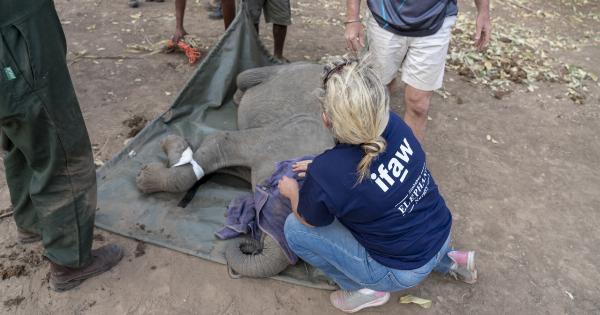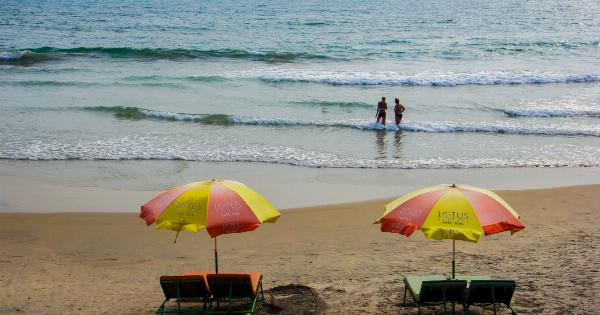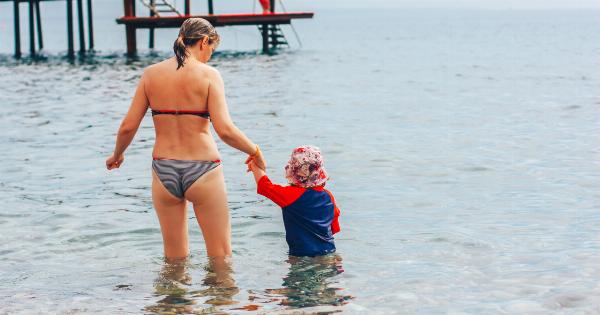Going to the beach with your kids is a great way to spend quality time together and enjoy the sun, sand, and surf. However, it’s important to be aware of potential hazards that can pose a risk to your children’s safety.
By being proactive and taking certain precautions, you can ensure a fun and safe beach outing for the whole family. Here are some hazards to watch out for:.
1. Sunburn
The sun’s harmful ultraviolet (UV) rays can cause sunburn, especially during peak hours between 10 am and 4 pm.
To protect your kids from painful sunburns and long-term skin damage, apply a broad-spectrum sunscreen with a high SPF, encourage them to wear protective clothing, like hats and rash guards, and seek shade during the hottest parts of the day.
2. Dehydration
Playing in the sand and water can be exhausting, and it’s easy for kids to become dehydrated, especially in hot weather. Make sure to pack plenty of water and encourage your children to drink frequently.
If they’re not keen on drinking plain water, you can offer them hydrating fruits like watermelon or snacks with high water content.
3. Heatstroke
Heatstroke is a severe form of heat illness that can occur when the body overheats. It can be life-threatening, particularly for young children.
If your child experiences symptoms like dizziness, nausea, rapid heartbeat, or stops sweating, move them to a cool, shaded area, give them water, and seek medical attention immediately.
4. Ocean Currents
Strong ocean currents can quickly pull unsuspecting swimmers away from the shore and into deeper waters.
Teach your kids to swim parallel to the shore if caught in a rip current until they’re out of its pull, rather than trying to swim directly back to land. Always supervise them closely while swimming and stay near lifeguarded areas.
5. Marine Life
Some marine animals, like jellyfish and stingrays, can be found in coastal waters. Teach your children to avoid touching any marine life they come across to avoid potential stings or bites.
If your child does get stung, carefully remove any visible tentacles or barbs, rinse the area with seawater, and seek medical attention if necessary.
6. Sand Hazards
While playing in the sand is fun, it can also pose some risks. Be cautious of sand dunes, as they can collapse and bury children, leading to suffocation.
Make sure your kids steer clear of any construction equipment, large holes, or sharp objects that may be buried in the sand.
7. Water Quality
Before heading to the beach, check local advisories regarding water quality. Some beaches may have high levels of bacteria or harmful algae blooms, which can cause illnesses if ingested or if the water comes into contact with open cuts or wounds.
If the water quality is questionable, it’s better to stay on the shore and explore other activities instead.
8. Crashing Waves
While the waves can be exciting, they can also be powerful and unpredictable. Teach your children to be cautious when playing near the water’s edge and avoid turning their backs to the waves.
Encourage them to never swim alone or go in water depths beyond their comfort and skill level.
9. Sun Overexposure
Aside from sunburns, prolonged sun exposure can lead to other health issues such as heat exhaustion and heatstroke.
Ensure your kids take regular breaks from the sun, preferably in shaded areas, and consider using beach umbrellas or tents to provide additional protection.
10. Lost Children
Beaches can be crowded, making it easy for kids to get separated from their parents or guardians. Establish a meeting point as soon as you arrive and teach your children to go there if they get lost.
Additionally, dressing your kids in bright and distinctive clothing can help you spot them more easily in a crowd.
By staying vigilant and taking these precautions, you can ensure a safe and enjoyable beach trip for your entire family.
Remember, a little preparation goes a long way in keeping your kids protected from potential hazards while they have fun in the sun and sand.































